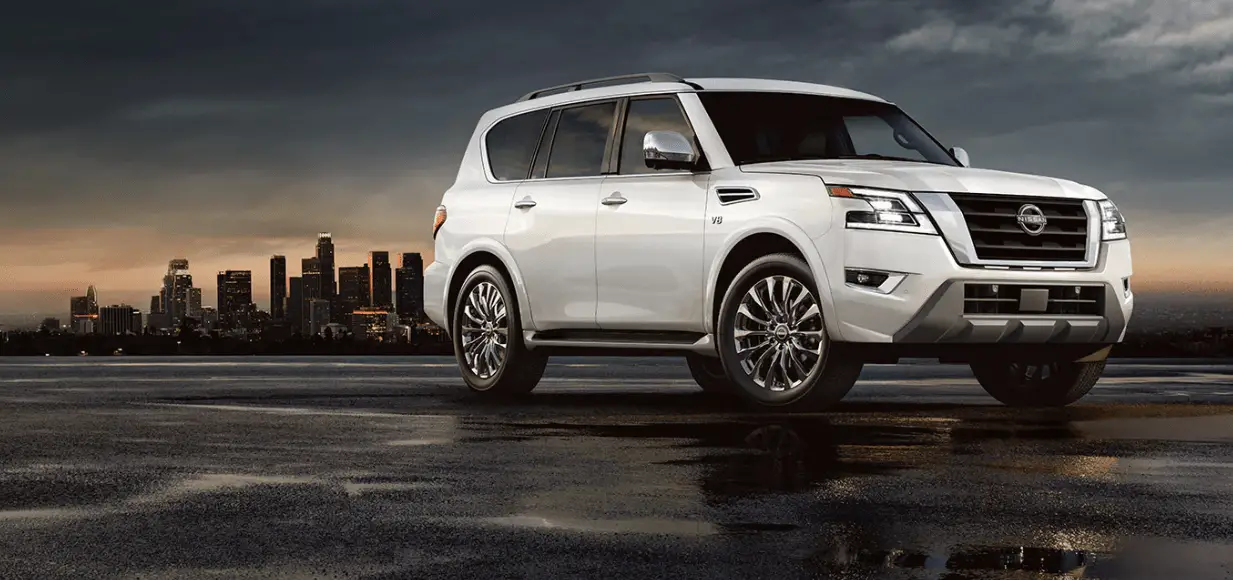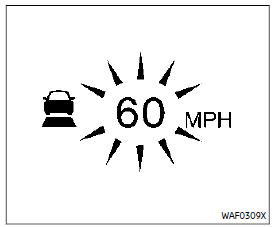Nissan ARMADA 2022 Intelligent Back-up Intervention and Intelligent Cruise Control
The Nissan Armada 2022 is a full-size SUV equipped with advanced safety features, such as Intelligent Back-up Intervention and Intelligent Cruise Control. Intelligent Back-up Intervention can help the driver avoid collisions while backing up by automatically applying the brakes to prevent a collision with objects or pedestrians. On the other hand, Intelligent Cruise Control allows the driver to set a preferred speed and following distance, and the vehicle will automatically adjust the speed to maintain the distance from the vehicle in front. In this guide, we will provide answers to frequently asked questions about the Nissan Armada 2022 Intelligent Back-up Intervention and Intelligent Cruise Control, including how to operate them, their advantages, and some recommendations for proper maintenance.
2023 Nissan Armada Specs, Price, Features and Mileage (Brochure)
Intelligent Back-up Intervention (I-BI) (if so equipped)
WARNING
Failure to follow the warnings and instructions for proper use of the I-BI system could result in serious injury or death.
- The I-BI system is not a replacement for proper driving procedures, is not designed to prevent contact with vehicles or objects and does not provide full brake power. When backing out of parking spaces, always use the inside and rear mirrors and turn and look in the direction you will move. Never rely solely on the I-BI system.
- There is a limitation to the detection capability of the radar or the sonar. Using the I-BI system un-der some road, ground, traffic or weather conditions could lead to improper system operation. Al-ways rely on your own operation to avoid accidents.
The I-BI system can help alert the driver of an approaching vehicle or objects behind the vehicle when the driver is backing out of a parking space.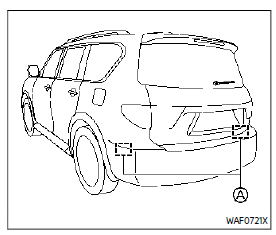
The I-BI system uses radar sensors installed on both sides near the rear bumper to detect an approaching vehicle and sonar sensors to detect objects in the rear.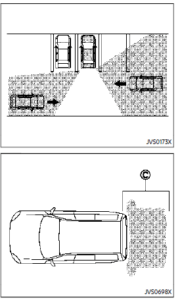
The radar sensors detect an approaching vehicle. The sonar sensors detect stationary objects behind the vehicle. Refer to the illustration for approximate zone coverage areas .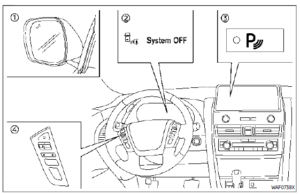
- Side indicator light
- I-BI OFF indicator
- “P” key (on the touch screen display) Steering-wheel-mounted controls (left side)
I-BI SYSTEM OPERATION
When the shift lever is in the R (Reverse) position and the vehicle speed is less than approximately 5 MPH (8 km/h), the I-BI system operates.
If the radar detects a vehicle approaching from the side or the sonar detects close stationary objects behind the vehicle, the system gives visual and audible warnings. If the driver does not apply the brakes, the system automatically applies the brake for a moment when the vehicle is moving backward. After the automatic brake application, the driver must depress the brake pedal to maintain brake pressure. If the driver’s foot is on the accelerator

pedal, the system pushes the accelerator upward before applying the brake. If you continue to accelerate, the system will not engage the brake.
 Touch screen display
Touch screen display
When the shift lever is placed in the R (Reverse) position, the indicator on the “P” key illuminates on the touch screen display.

If the radar detects an approaching vehicle from the side, the system chimes (once), the side indicator light on the side the vehicle is approaching flashes and a yellow rectangular frame appears on the touchscreen display.
- In the case of several vehicles approaching in a row (Illustration 1) or in the opposite direction (Illustration 2), a chime may not be issued to the I-BI system after the first vehicle passes the sensors.
- The sonar system chime indicating there is an object behind the vehicle has a higher priority than the I-BI chime (single beep) indicating an approaching vehicle. If the sonar system detects an object behind the vehicle and the I-BI system detects an approaching vehicle at the same time, the following indications are provided:— The sonar system chime sounds— The side indicator light on the side
of the approaching vehicle flashes, and- A yellow rectangular frame appears in the touchscreen display.

If an approaching vehicle or close object behind the vehicle is detected when your vehicle is backing up, a red frame will appear in the touchscreen display and the system will chime three times. Then, the brakes will be applied momentarily. After the automatic brake application, the driver must depress the brake pedal to maintain brake pressure.
If the driver’s foot is on the accelerator pedal, the system moves the accelerator pedal upward before the braking is applied. However, if you continue to accelerate, the system will not engage the brakes.
The I-BI system does not operate if the object is very close to the bumper.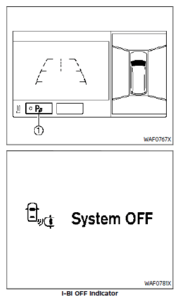
The I-BI system can be turned off temporarily by touching the “P” key on the touchscreen display. The indicator on the “P” key turns off and the I-BI OFF indicator appears on the vehicle information display. When the shift lever is placed in the R (Reverse) position again, the I-BI system is turned on.
NOTE:
- When the “P” key is touched, the indicator light on the key will turn off and the I-BI system will turn off temporarily. The Moving Object Detection (MOD), the Rear Automatic Braking (RAB), and the sonar systems will also be turned off at the same time.
- When the sonar and MOD systems are turned off on the settings menu in the touchscreen display, the “P” key will disappear.
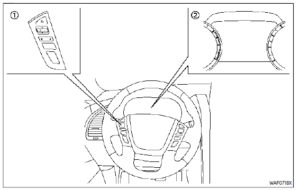
- Steering-wheel-mounted control (left side)
- Vehicle information display
HOW TO ENABLE/DISABLE THE I-BI SYSTEM
- 1. Push the button until “Settings” appears in the vehicle information display and then push the OK. Use the to select “Driver Assistance”. Then push the OK.
- Select “Emergency Brake” and push the OK.
- Select “Rear” and use the OK to turn the system on or off.
NOTE:
- The I-BI system will be automatically turned on when the engine is restarted.
- The I-BI system is integrated into the RAB system. There is not separate selection for the I-BI system. When the RAB system is also turned off.
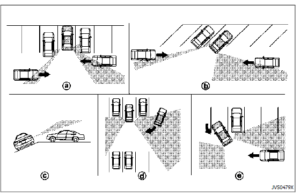
I-BI SYSTEM PRECAUTIONS
WARNING
Listed below are the system limitations for the I-BI system. Failure to operate the vehicle in accordance with these system limitations could result in serious injury or death.
with these system, limitations could result in serious injury or death.
- Always check your surroundings and turn to check what is behind you before backing up.
- The radar sensors detect approaching (moving) vehicles. The radar sensors cannot detect every object such as:
- Pedestrians, bicycles, animals or child-operated toy vehicles
- A vehicle that passes at speeds greater than approximately 15 MPH (24 km/h)approaching vehicles in certain situations:
- Illustration a. When a vehicle parked next to you obstructs the beam of the radar sensor.
- Illustration b. When the vehicle is parked in an angled parking space.
- Illustration c. When the vehicle is parked on the inclined ground.
- Illustration d. When an approaching vehicle turns into your vehicle’s parking lot aisle.
- Illustration e. When the angle formed by your vehicle and the approaching vehicle is small.
- The following conditions may reduce the ability of the radar sensors to detect other vehicles:
- Severe weather
- Road spray
- Ice/frost/dirt build up on the vehicle
- Do not attach stickers (including transparent material), install accessories or apply additional paint near the radar sensors. These conditions may reduce the ability of the radar sensors to detect other vehicles.
- The sonar sensors detect stationary objects behind the vehicle. The sonar sensor may not detect:
- Small or moving objects
- Wedge-shaped objects
- Object close to the bumper (less than approximately 1 ft (30 cm))
- Thin objects such as rope, wire, and chain, etc.
- The brake engagement by the I- BI system is not as effective on a slope as it is on flat ground. When on a steep slope the system may not function properly.
- Do not use the I-BI system under the following conditions because the system may not function properly.
- When driving with a tire that is not within normal tire conditions (for example, tire wear, low tire pressure, installation of spare tire, tire chains, non-standard wheels).
- When the vehicle is equipped with non-original brake parts or suspension parts.
- When towing a trailer or other vehicle, turn the I-BI system off to prevent the occurrence of an unexpected accident resulting from sudden system operation.
- Excessive noise (for example, audio system volume, open vehicle window) will interfere with the chime sound, and it may not be heard.
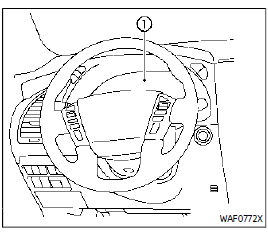
Vehicle information display
SYSTEM TEMPORARILY UNAVAILABLE
When any of the following messages appear on the vehicle information display, a chime will sound and the I-BI system will be turned off automatically.
- “Unavailable: High Accelerator Temperature”:
If the vehicle is parked in direct sunlight under high-temperature conditions (over approximately 104°F (40°C)). - “Unavailable Side Radar Obstruction”:
When side radar blockage is detected.
Turn off the I-BI system and turn it on again when the above conditions no longer exist.
2023 Nissan Armada Specs, Price, Features and Mileage (Brochure)
SYSTEM MALFUNCTION
If the I-BI system malfunctions, it will turn off automatically, a chime will sound and a “Malfunction” warning message will appear in the vehicle information display.
Action to take
Stop the vehicle in a safe location and place the shift lever in the P (Park) position. Turn the engine off and restart the engine. If the warning message continues to appear, have the system checked. It is recommended you visit a NISSAN dealer for this service.
SYSTEM MAINTENANCE
The two radar sensors for the I-BI system are located near the rear bumper. Always keep the area near the radar sensors clean. The radar sensors may be blocked by temporary ambient conditions such as splashing water, mist or fog. The blocked condition may also be caused by objects such as ice, frost or dirt obstructing the radar sensors. Check for and remove objects obstructing the area around the radar sensors. Do not attach stickers (including transparent material), install accessories or apply additional paint near the radar sensors. Do not strike or damage the area around the radar sensors. It is recommended you visit a NISSAN dealer if the area around the radar sensors is damaged due to a collision.
Radiofrequency statement
For USA:
FCC ID: OAYSRR3B
This device complies with Part 15 of the FCC Rules. Operation is subject to the following two conditions:
- this device may not cause harmful interference, and
- this device must accept any interference received, including interference that may cause undesired operation.
CAUTION TO USERS
Changes or modifications not expressly approved by the party responsible for compliance could void the user’s authority to operate the equipment.
For Canada:
This device complies with Industry Cana-da licence-exempt RSS standard(s). Operation is subject to the following two conditions: (1) this device may not cause interference, and (2) this device must accept any interference, including interference that may cause undesired operation of the device.
Frequency bands: 24.05 – 24.25 Ghz
The field strength of SRR3-B is below 250 millivolts/m measured at 3 metres with an average detector.
This device contains license-exempt transmitter(s)/receiver(s) that comply with Innovation, Science, and Economic Development Canada’s licence-exempt RSS(s). Operation is subject to the following two conditions:
- This device may not cause interference.
- This device must accept any interference, including interference that may cause undesired operation of the device.
Radiofrequency radiation exposure information:
This equipment complies with radiation exposure limits set forth for an uncontrolled environment. This equipment should be installed and operated with minimum distance of 20 cm between the radiator and your body.
INTELLIGENT CRUISE CONTROL (ICC)
WARNING
Failure to follow the warnings and instructions for proper use of the ICC system could result in serious injury or death.
- ICC is not a collision avoidance or warning device. For highway use only and it is not intended for congested areas or city driving. Failure to apply the brakes could result in an accident.
- Always observe posted speed limits and do not set the speed over them.
- Always drive carefully and attentively when using either cruise control mode. Read and understand the Owner’s Manual thoroughly before using the cruise control. To avoid serious injury or death, do not rely on the system to prevent accidents or to control the vehicle’s speed in emergency situations. Do not use cruise control except in appropriate road and traffic conditions.
- In the conventional (fixed speed) cruise control mode, a warning chime will not sound to warn you if you are too close to the vehicle ahead. Pay special attention to the distance between your vehicle and the vehicle ahead of you or a collision could occur.
The ICC system maintains a selected distance from the vehicle in front of you within the speed range of 0 to 90 MPH (0 to 144 km/h) up to the set speed. The set speed can be selected by the driver between 20 to 90 MPH (30 to 144 km/h). The vehicle travels at a set speed when the road ahead is clear. The ICC system can be set to one of two cruise control modes.
- Vehicle-to-vehicle distance control mode:
For maintaining a selected distance between your vehicle and the vehicle in front of you up to the preset speed.
Intelligent Back-up Intervention (I-BI) (if so equipped)
WARNING
Failure to follow the warnings and instructions for proper use of the I-BI system could result in serious injury or death.
- The I-BI system is not a replacement for proper driving procedures, is not designed to prevent contact with vehicles or objects and does not provide full brake power. When backing out of parking spaces, always use the inside and rear mirrors and turn and look in the direction you will move. Never rely solely on the I-BI system.
- There is a limitation to the detection capability of the radar or the sonar. Using the I-BI system under some road, ground, traffic or weather conditions could lead to improper system operation. Always rely on your own operation to avoid accidents.
The I-BI system can help alert the driver of an approaching vehicle or objects behind the vehicle when the driver is backing out of a parking space.

The I-BI system uses radar sensors installed on both sides near the rear bumper to detect an approaching vehicle and sonar sensors to detect objects in the rear.

The radar sensors detect an approaching vehicle. The sonar sensors detect stationary objects behind the vehicle. Refer to the illustration for approximate zone coverage areas .

- Side indicator light
- I-BI OFF indicator
- “P” key (on the touch screen display) Steering-wheel-mounted controls (left side)
I-BI SYSTEM OPERATION
When the shift lever is in the R (Reverse) position and the vehicle speed is less than approximately 5 MPH (8 km/h), the I-BI system operates.
If the radar detects a vehicle approaching from the side or the sonar detects close stationary objects behind the vehicle, the system gives visual and audible warnings. If the driver does not apply the brakes, the system automatically applies the brake for a moment when the vehicle is moving backwards. After the automatic brake application, the driver must depress the brake pedal to maintain brake pressure. If the driver’s foot is on the accelerator

pedal, the system pushes the accelerator upward before applying the brake. If you continue to accelerate, the system will not engage the brake.
 Touch screen display
Touch screen display
When the shift lever is placed in the R (Reverse) position, the indicator on the “P” key illuminates on the touch screen display.

If the radar detects an approaching vehicle from the side, the system chimes (once), the side indicator light on the side the vehicle is approaching from flashes and a yellow rectangular frame appears on the touchscreen display.

- In the case of several vehicles approaching in a row (Illustration 1) or in the opposite direction (Illustration 2), a chime may not be issued to the I-BI system after the first vehicle passes the sensors.
- The sonar system chime indicating there is an object behind the vehicle has a higher priority than the I-BI chime (single beep) indicating an approaching vehicle. If the sonar system detects an object behind the vehicle and the I-BI system detects an approaching vehicle at the same time, the following indications are provided:— The sonar system chime sounds— The side indicator light on the side of the approaching vehicle flashes, and
- A yellow rectangular frame appears in the touchscreen display.

If an approaching vehicle or close object behind the vehicle is detected when your vehicle is backing up, a red frame will appear in the touchscreen display and the system will chime three times. Then, the brakes will be applied momentarily. After the automatic brake application, the driver must depress the brake pedal to maintain brake pressure.
If the driver’s foot is on the accelerator pedal, the system moves the accelerator pedal upward before the braking is applied. However, if you continue to accelerate, the system will not engage the brakes.
The I-BI system does not operate if the object is very close to the bumper.
The I-BI system can be turned off temporarily by touching the “P” key on the touchscreen display. The indicator on the “P” key turns off and the I-BI OFF indicator appears on the vehicle information display. When the shift lever is placed in the R (Reverse) position again, the I-BI system is turned on.
NOTE:
- When the “P” key is touched, the indicator light on the key will turn off and the I-BI system will turn off temporarily. The Moving Object Detection (MOD), the Rear Automatic Braking (RAB) and the sonar systems will also be turned off at the same time.
- When the sonar and MOD systems are turned off on the settings menu in the touchscreen display, the “P” key will disappear.

- Steering-wheel-mounted control (left side)
- Vehicle information display
HOW TO ENABLE/DISABLE THE I-BI SYSTEM
- 1. Push the button until “Settings” appears in the vehicle information display and then push the OK. Use the to select “Driver Assistance”. Then push the OK.
- Select “Emergency Brake” and push the OK.
- Select “Rear” and use the OK to turn the system on or off.
NOTE:
- The I-BI system will be automatically turned on when the engine is restarted.
- The I-BI system is integrated into the RAB system. There is not separate selection for the I-BI system. When the RAB system is also turned off.

I-BI SYSTEM PRECAUTIONS
WARNING
Listed below are the system limitations for the I-BI system. Failure to operate the vehicle in accordance with these system limitations could result in serious injury or death.
with this system, limitations could result in serious injury or death.
- Always check your surroundings and turn to check what is behind you before backing up.
- The radar sensors detect approaching (moving) vehicles. The radar sensors cannot detect every object such as:
- Pedestrians, bicycles, animals or child-operated toy vehicles
- A vehicle that passes at speeds greater than approximately 15 MPH (24 km/h)approaching vehicles in certain situations:
- Illustration a. When a vehicle parked next to you obstructs the beam of the radar sensor.
- Illustration b. When the vehicle is parked in an angled parking space.
- Illustration c. When the vehicle is parked on the inclined ground.
- Illustration d. When an approaching vehicle turns into your vehicle’s parking lot aisle.
- Illustration e. When the angle formed by your vehicle and the approaching vehicle is small.
- The following conditions may reduce the ability of the radar sensors to detect other vehicles:
- Severe weather
- Road spray
- Ice/frost/dirt build up on the vehicle
- Do not attach stickers (including transparent material), install accessories or apply additional paint near the radar sensors. These conditions may reduce the ability of the radar sensors to detect other vehicles.
- The sonar sensors detect stationary objects behind the vehicle. The sonar sensor may not detect:
- Small or moving objects
- Wedge-shaped objects
- Object close to the bumper (less than approximately 1 ft (30 cm))
- Thin objects such as rope, wire and chain, etc.
- The brake engagement by the I- BI system is not as effective on a slope as it is on flat ground. When on a steep slope the system may not function properly.
- Do not use the I-BI system under the following conditions because the system may not function properly.
- When driving with a tire that is not within normal tire conditions (for example, tire wear, low tire pressure, installation of spare tire, tire chains, non-standard wheels).
- When the vehicle is equipped with non-original brake parts or suspension parts.
- When towing a trailer or other vehicle, turn the I-BI system off to prevent the occurrence of an un-expected accident resulting from sudden system operation. (See “I-BI system operation” (P.5-65).)
- Excessive noise (for example, audio system volume, open vehicle window) will interfere with the chime sound, and it may not be heard.

Vehicle information display
SYSTEM TEMPORARILY UNAVAILABLE
When any of the following messages appear on the vehicle information display , a chime will sound and the I-BI system will be turned off automatically.
- “Unavailable: High Accelerator Temperature”:
If the vehicle is parked in direct sunlight under high-temperature conditions (over approximately 104°F (40°C)). - “Unavailable Side Radar Obstruction”:
When side radar blockage is detected.
Turn off the I-BI system and turn it on again when the above conditions no longer exist.
SYSTEM MALFUNCTION
If the I-BI system malfunctions, it will turn off automatically, a chime will sound and “Malfunction” warning message will appear in the vehicle information display .
Action to take
Stop the vehicle in a safe location and place the shift lever in the P (Park) position. Turn the engine off and restart the engine. If the warning message continues to appear, have the system checked. It is recommended you visit a NISSAN dealer for this service.

SYSTEM MAINTENANCE
The two radar sensors for the I-BI system are located near the rear bumper. Always keep the area near the radar sensors clean.
The radar sensors may be blocked by temporary ambient conditions such as splashing water, mist or fog.
The blocked condition may also be caused by objects such as ice, frost or dirt obstructing the radar sensors.
Check for and remove objects obstructing the area around the radar sensors.
Do not attach stickers (including trans-parent material), install accessories or apply additional paint near the radar sensors.
Do not strike or damage the area around the radar sensors.
It is recommended you visit a NISSAN dealer if the area around the radar sensors is damaged due to a collision.
Radio frequency statement
For USA:
FCC ID: OAYSRR3B
This device complies with Part 15 of the FCC Rules. Operation is subject to the following two conditions:
- this device may not cause harmful interference, and
- this device must accept any interference received, including interference that may cause undesired operation.
CAUTION TO USERS
Changes or modifications not expressly approved by the party responsible for compliance could void the user’s authority to operate the equipment.
For Canada:
This device complies with Industry Cana-da licence-exempt RSS standard(s). Operation is subject to the following two conditions: (1) this device may not cause interference, and (2) this device must accept any interference, including interference that may cause undesired operation of the device.
Frequency bands: 24.05 – 24.25 Ghz
The field strength of SRR3-B is below 250 millivolts/m measured at 3 metres with an average detector.
This device contains licence-exempt transmitter(s)/receiver(s) that comply with Innovation, Science and Economic Development Canada’s license-exempt RSS(s). Operation is subject to the following two conditions:
- This device may not cause interference.
- This device must accept any interference, including interference that may cause undesired operation of the device.
Radiofrequency radiation exposure information:
This equipment complies with radiation exposure limits set forth for an uncontrolled environment. This equipment should be installed and operated with minimum distance of 20 cm between the radiator and your body.
INTELLIGENT CRUISE CONTROL (ICC)
WARNING
Failure to follow the warnings and instructions for proper use of the ICC system could result in serious injury or death.
- ICC is not a collision avoidance or warning device. For highway use only and it is not intended for congested areas or city driving. Failure to apply the brakes could result in an accident.
- Always observe posted speed limits and do not set the speed over them.
- Always drive carefully and attentively when using either cruise control mode. Read and understand the Owner’s Manual thoroughly before using the cruise control. To avoid serious injury or death, do not rely on the system to prevent accidents or to control the vehicle’s speed in emergency situations. Do not use cruise control except in appropriate road and traffic conditions.
- In the conventional (fixed speed) cruise control mode, a warning chime will not sound to warn you if you are too close to the vehicle ahead. Pay special attention to the distance between your vehicle and the vehicle ahead of you or a collision could occur.
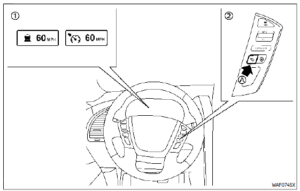
- Displays and indicators
- ICC switches
- MAIN (ON·OFF) switch
Push the MAIN switch to choose the cruise control mode between the vehicle-to-vehicle distance control mode and the conventional (fixed speed) cruise control mode.
Once a control mode is activated, it cannot be changed to the other cruise control mode. To change the mode, push the MAIN switch once to turn the system off. Then push the MAIN switch again to turn the system back on and select the desired cruise control mode.
Always confirm the setting in the ICC system display.
For the vehicle-to-vehicle distance control mode, see “Vehicle-to-vehicle distance control mode” (P.5-76).
For the conventional (fixed speed) cruise control mode, see “Conventional (fixed speed) cruise control mode” (P.5-92).

HOW TO SELECT THE CRUISE CONTROL MODE
Selecting vehicle-to-vehicle dis-ance control mode To choose the vehicle-to-vehicle distance control mode, quickly push and release the MAIN switch.
Selecting the conventional (fixed speed) cruise control mode To choose the conventional (fixed speed) cruise control mode, push and hold the MAIN switch for longer than approximately 1.5 seconds. See “Conventional (fixed speed) cruise control mode” (P.5-)

2023 Nissan Armada Specs, Price, Features and Mileage (Brochure)
VEHICLE-TO-VEHICLE DISTANCE CONTROL MODE
In the vehicle-to-vehicle distance control mode, the ICC system automatically maintains a selected distance from the vehicle traveling in front of you according to that vehicle’s speed (up to the set speed), or at the set speed when the road ahead is clear.
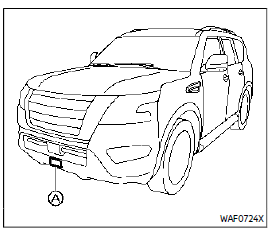
The system is intended to enhance the operation of the vehicle when following a vehicle traveling in the same lane and direction.
If the radar sensor detects a slower-moving vehicle ahead, the system will reduce the vehicle speed so that your vehicle follows the vehicle in front at the selected distance.
The system automatically controls the throttle and applies the brakes (up to approximately 40% of vehicle braking power) if necessary.
The detection range of the sensor is approximately 650 ft (200 m) ahead.
Vehicle-to-vehicle distance control mode operation
The vehicle-to-vehicle distance control mode is designed to maintain a selected distance and reduce the speed to match the slower vehicle ahead; the system will decelerate the vehicle as necessary and if the vehicle ahead comes to a stop, the vehicle decelerates to a standstill. However, the ICC system can only apply up to approximately 40% of the vehicle’s total braking power. This system should only be used when traffic conditions allow vehicle speeds to remain fairly constant or when vehicle speeds change gradually. If a vehicle moves into the traveling lane ahead or if a vehicle traveling ahead rapidly decelerates, the distance between vehicles may become closer because the ICC system cannot decelerate the vehicle quickly enough. If this occurs, the ICC system will sound a warning chime and blink the system display to notify the driver to take necessary action.
The system will cancel and a warning chime will sound if the speed is below approximately 15 MPH (25 km/h) and a vehicle is not detected ahead. The system will also disengage when the vehicle goes above the maximum set speed.
The following items are controlled in the vehicle-to-vehicle distance control mode:
- When there are no vehicles traveling ahead, the vehicle-to-vehicle distance control mode maintains the speed set by the driver. The set speed range is between approximately 20 and 90 MPH (30 and 144 km/h).
- When there is a vehicle traveling ahead, the vehicle-to-vehicle distance control mode adjusts the speed to maintain the distance, selected by driver, from the vehicle ahead. The adjusting speed range is up to the set speed. If the vehicle ahead comes to a stop, the vehicle decelerates to a standstill within the limitations of the system. The system will cancel once it judges a standstill with a warning chime.
- When the vehicle traveling ahead has moved out from its lane of travel, the vehicle-to-vehicle distance control mode accelerates and maintains vehicle speed up to the set speed.
The ICC system does not control vehicle speed or warn you when you approach stationary and slow-moving vehicles. You must pay attention to vehicle operation to maintain proper distance from vehicles ahead when approaching toll gates or traffic congestion.
The ICC system does not control vehicle speed or warn you when you approach stationary and slow moving vehicles. You must pay attention to vehicle operation to maintain proper distance from vehicles ahead when approaching toll gates or traffic congestion.

When driving on the freeway at a set speed and approaching a slower traveling vehicle ahead, the ICC system will adjust the speed to maintain the distance, selected by the driver, from the vehicle ahead. If the vehicle ahead changes lanes or exits the freeway, the ICC system will accelerate and maintain the speed up to the set speed. Pay attention to the driving operation to maintain control of the vehicle as it accelerates to the set speed.
The vehicle may not maintain the set speed on winding or hilly roads. If this occurs, you will have to manually control the vehicle speed.
Normally when controlling the distance to a vehicle ahead, this system automatically accelerates or decelerates your vehicle according to the speed of the vehicle ahead. Depress the accelerator to properly accelerate your vehicle when acceleration is required for a lane change. Depress the brake pedal when deceleration is required to maintain a safe distance to the vehicle ahead due to its sudden braking or if a vehicle cuts in. Always stay alert when using the ICC system.

Vehicle-to-vehicle distance control mode switches
The system is operated by a MAIN switch and four control switches, all mounted on the steering wheel.
- RES+ switch:
Resumes set speed or increase speed incrementally. - SET- switch:
Sets desired cruise speed, and reduces speed incrementally. - DISTANCE switch:
Changes the vehicle’s following distance:- Long
- Middle
- Short
- CANCEL switch:
Deactivates the system without erasing
the set speed. - MAIN switch:
Master switch to activate the system
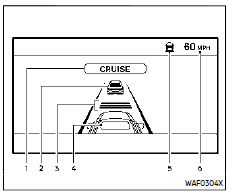
- Vehicle-to-vehicle distance control mode display and indicators
The display is located between the speedometer and tachometer..1. MAIN switch indicator:
Indicates that the MAIN switch is ON. - Vehicle ahead detection indicator: Indicates whether it detects a vehicle in front of you.
- Set distance indicator:
Displays the selected distance between vehicles set with the DISTANCE switch. - Indicates your vehicle
- This indicator indicates the ICC system status depending on a color.
- Intelligent Cruise Control system ON indicator (gray): Indicates that the MAIN switch is ON.
- Intelligent Cruise Control system set indicator (green): Indicates that cruising speed is set.
- Intelligent Cruise Control system warning (yellow): Indicates that if there is a malfunction in the ICC system.
- Set vehicle speed indicator:
Indicates the set vehicle speed.
For Canadian models, the speed is displayed in km/h.
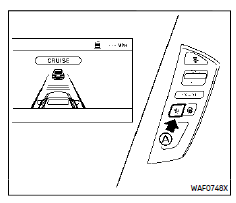
Operating vehicle-to-vehicle distance control mode
To turn on the cruise control, quickly push and release the MAIN switch on. The MAIN switch indicator, set distance indicator and set vehicle speed indicator come on and in a standby state for setting.

To set cruising speed, accelerate your vehicle to the desired speed, push the SET- switch and release it. (Vehicle ahead detection indicator, set distance indicator and set vehicle speed indicator come on.) Take your foot off the accelerator pedal. Your vehicle will maintain the set speed.
When the SET- switch is pushed under the following conditions, the system cannot be set and the ICC indicators will blink for approximately 2 seconds:
- When traveling below 20 MPH (30 km/h) and the vehicle ahead is not detected
- When the shift lever is not in the D (Drive) or manual shift mode
- When the parking brake is applied
- When the brakes are operated by the driver
When the SET- switch is pushed under the following conditions, the system cannot be set.
A warning chime will sound and a message will pop up. - “Currently unavailable/Currently not available”:
- When the SNOW mode is pushed (SNOW mode switch) (To use the ICC system, turn off the SNOW mode switch, push the MAIN switch to turn off the ICC and reset the ICC switch by pushing the MAIN switch again.)
- When the 4WD shift switch is in the 4H or 4L position. (To use the ICC system, place the 4WD shift switch in the AUTO position, push the MAIN switch to turn off the ICC system and reset the ICC switch by pushing the MAIN switch again (for 4WD models).
- When the VDC system is off (To use the ICC system, turn on the VDC system. Push the MAIN switch to turn off the ICC system and reset the ICC switch by pushing the MAIN switch again.)
- “Not available: Poor Road Conditions”:
- When the VDC (including the traction control system) is operating
- When a wheel is slipping (To use the ICC system, make sure the wheels are no longer slipping. Push the MAIN switch to turn off the ICC, and reset the ICC system by pushing the MAIN switch again.)
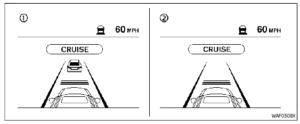
- The system set to display with the vehicle ahead
- System set display without vehicle ahead
The driver sets the desired vehicle speed based on the road conditions. The ICC system maintains the set vehicle speed, similar to standard cruise control, as long as no vehicle is detected in the lane ahead.
The ICC system displays the set speed.
Vehicle detected ahead:
When a vehicle is detected in the lane ahead, the ICC system decelerates the vehicle by controlling the throttle and applying the brakes to match the speed of a slower vehicle ahead. The system then controls the vehicle’s speed based on the speed of the vehicle ahead to maintain the driver selected distance.
NOTE:
- The stoplights of the vehicle come on when braking is performed by the ICC system.
- When the brake operates, a noise may be heard and/or vibration may be felt. This is not a malfunction.
When a vehicle ahead is detected, the vehicle ahead detection indicator comes on. The ICC system will also display the set speed and selected distance.
The vehicle ahead not detected:
When a vehicle is no longer detected ahead, the ICC system gradually accelerates your vehicle to resume the previously set vehicle speed. The ICC system then maintains the set speed.
When a vehicle is no longer detected the vehicle ahead detection indicator turns off.
If a vehicle ahead appears during acceleration to the set vehicle speed or any time the ICC system is in operation, the system controls the distance to that vehicle.
When a vehicle is no longer detected under approximately 15 MPH (25 km/h), the system will be canceled.
When passing another vehicle, the set speed indicator will flash when the vehicle speed exceeds the set speed. The vehicle detect indicator will turn off when the area ahead of the vehicle is open. When the pedal is released, the vehicle will return to the previously set speed.
Even though your vehicle speed is set in the ICC system, you can depress the accelerator pedal when it is necessary to accelerate your vehicle rapidly.
How to change set vehicle speed
To cancel the preset speed, use any of these methods:
- Push the CANCEL switch. The set vehicle speed indicator will go out.
- Tap the brake pedal. The set vehicle speed indicator will go out.
- Turn the MAIN switch off. Both the MAIN switch indicator and set vehicle speed indicator will go out.
To reset at a faster cruising speed, use one of the following methods:
- Depress the accelerator pedal. When the vehicle attains the desired speed, push and release the SET- switch.
- Push and hold the RES+ switch. The set vehicle speed will increase by approximately 5 MPH (5 km/h for Canada).
- . Push, then quickly release the RES+ switch. Each time you do this, the set speed will increase by approximately 1 MPH (1 km/h for Canada).
- To reset at a slower cruising speed, use one of the following methods:
- Lightly tap the brake pedal. When the vehicle attains the desired speed, push the SET- switch and release it.
- Push and hold the SET- switch. The set vehicle speed will decrease by approximately 5 MPH (5 km/h for Canada).
- Push, then quickly release the SET switch. Each time you do this, the set speed will decrease by approximately 1 MPH (1 km/h for Canada).
To resume the preset speed, push and release the RES+ switch. The vehicle will resume the last set cruising speed when the vehicle speed is over 20 MPH (30 km/h).
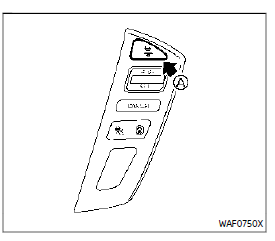
How to change set distance to vehicle ahead
The distance to the vehicle ahead can be selected at any time depending on the traffic conditions.
Each time the DISTANCE switch is pushed, the set distance will change to long, middle, short and back to long again in that sequence.

- The distance to the vehicle ahead will change according to the vehicle speed. The higher the vehicle speed, the longer the distance.
- If the engine is stopped, the set distance becomes “long”. (Each time the engine is started, the initial setting becomes “long”.)
Approach warning
If your vehicle comes closer to the vehicle ahead due to rapid deceleration of that vehicle or if another vehicle cuts in, the system warns the driver with the chime and ICC system display. Decelerate by depressing the brake pedal to maintain a safe vehicle distance if:
- The chime sounds.
- The vehicle ahead detection and set distance indicator blink.
The warning chime may not sound in some cases when there is a short distance between vehicles. Some examples are:
- When the vehicles are travelling at the same speed and the distance between vehicles is not changing
- When the vehicle ahead is travelling faster and the distance between vehicles is increasing
- When a vehicle cuts in near your vehicle
The warning chime will not sound when: - Your vehicle approaches other vehicles that are parked or moving slowly.
- The accelerator pedal is depressed, overriding the system.
NOTE:
The approach warning chime may sound and the system display may blink when the radar sensor detects objects on the side of the vehicle or on the side of the road. This may cause the ICC system to decelerate or accelerate the vehicle. The radar sensor may detect these objects when the vehicle is driven on winding roads, narrow roads, hilly roads or when entering or exiting a curve. In these cases you will have to manually control the proper distance ahead of your vehicle.
Also, the sensor sensitivity can be affected by vehicle operation (steering manoeuvre or driving position in the lane) or traffic or vehicle condition (for example, if a vehicle is being driven with some damage).
Acceleration when passing
When the ICC system is engaged above 44 MPH (70 km/h) and following a slower vehicle (below the vehicle set speed), and the turn signal is activated to the left, the ICC system will automatically start to accelerate the vehicle to help initiate passing on the left and will begin to reduce the distance to vehicle directly ahead. Only the left side turn signal operates this feature. As the driver steers the vehicle and moves into the passing lane, if no vehicle is detected ahead the ICC system will continue to accelerate to the vehicle set speed. If another vehicle is detected ahead, then the vehicle will accelerate up to the following speed of that vehicle. If the vehicle is not steered into the left lane to pass, the acceleration will stop after a short time and regain the set the following distance. Acceleration can be stopped at any point by depressing the brake pedal or the CANCEL switch on the steering wheel.
WARNING
In order to reduce the risk of a collision that may result in serious injury or death, please be aware of the following:
- This function is only activated with the left turn signal and will briefly accelerate the vehicle even if a lane change is not initiated. This can include non-passing situations such as left side exits.
- Ensure that when passing another vehicle, the adjacent lane is clear before initiating the pass. Sudden changes in traffic may occur while passing. Always manually steer or brake as needed. Never solely rely on the system.
Automatic cancellation
A chime sounds under the following conditions and the control is automatically canceled.
- When the vehicle ahead is not detected and your vehicle is traveling below the speed of 15 MPH (25 km/h)
- When the system judges the vehicle is at standstill
- When the shift lever is not in the D (Drive) or manual shift mode
- When the parking brake is applied
- When the SNOW mode switch is pushed on.
- When the 4WD shift switch is in the 4H or 4L position (for 4WD models)
- When the VDC system is turned off
- When the VDC (including the traction control system) operates
- When distance measurement becomes impaired due to adhesion of dirt or obstruction to the sensor
- When a wheel slips
- When the radar signal is temporarily interrupted Vehicle-to-vehicle distance control mode limitations
WARNING
Listed below are the system limitations for the ICC system. Failure to operate the vehicle in accordance with these system limitations could result in serious injury or death.
- The system is primarily intended for use on straight, dry, open roads with light traffic. It is not advisable to use the system in city traffic or congested areas.
- . This system will not adapt automatically to road conditions. This system should be used in evenly flowing traffic. Do not use the system on roads with sharp curves, or on icy roads, in heavy rain or in fog.
- . As there is a performance limit to the distance control function, never rely solely on the ICC system. This system does not correct careless, inattentive or absent-minded driving, or overcome poor visibility in rain, fog, or other bad weather. Decelerate the vehicle speed by depressing the brake pedal, depending on the distance to the vehicle ahead and the surrounding circum-stances in order to maintain a safe distance between vehicles.
- . If the vehicle ahead comes to a stop, the vehicle decelerates to a standstill within the limitations of the system. The system will cancel once it judges that the vehicle has come to a standstill and sound a warning chime. To pre-vent the vehicle from moving, the driver must depress the brake pedal.
- . Always pay attention to the operation of the vehicle and be ready to manually control the proper following distance. The vehicle-to-vehicle distance control mode of the ICC system may not be able to maintain the selected distance between vehicles (following distance) or selected vehicle speed under some circumstances.
- . The system may not detect the vehicle in front of you in certain road or weather conditions. To avoid accidents, never use the ICC system under the following conditions:
- On roads where the traffic is heavy or there are sharp curves
- On slippery road surfaces such as on ice or snow, etc.
- During bad weather (rain, fog, snow, etc.)
- When rain, snow or dirt adhere to the system sensor
- On steep downhill roads (the vehicle may go beyond the set vehicle speed and frequent braking may result in over-heating the brakes)
- On repeated uphill and downhill roads
- When traffic conditions make it difficult to keep a proper distance between vehicles because of frequent acceleration or deceleration
- Do not use the ICC system if you are towing a trailer. The system may not detect a vehicle ahead.
- In some road or traffic conditions, a vehicle or object can unexpectedly come into the sensor detection zone and cause automatic braking. You may need to control
the distance from other vehicles using the accelerator pedal. Always stay alert and avoid using the ICC system when it is not recommended in this section.
- The radar sensor will not detect the following objects:
- Stationary and slow-moving vehicles
- Pedestrians or objects in the roadway
- Oncoming vehicles in the same lane
- Motorcycles travelling offset in the travel lane
The sensor generally detects the signals returned from the vehicle ahead. Therefore, if the sensor cannot detect the reflection from the vehicle ahead, the ICC system may not maintain the selected distance.
The following are some conditions in which the sensor cannot detect the signals:
- When the snow or road spray from traveling vehicles reduces the sensor’s visibility
- When excessively heavy baggage is loaded in the rear seat or the luggage area of your vehicle
- When your vehicle is towing a trailer, etc.
The ICC system is designed to automatically check the sensor’s operation within the limitation of the system. When the sensor is covered with dirt or is obstructed, the system will automatically be cancelled. If the sensor is covered with ice, a transparent or translucent vinyl bag, etc., the ICC system may not detect them. In these instances, the vehicle-to-vehicle distance control mode may not cancel and may not be able to maintain the selected following distance from the vehicle ahead. Be sure to check and clean the sensor regularly.

The detection zone of the ICC sensor is limited. A vehicle ahead must be in the detection zone for the vehicle-to-vehicle distance detection mode to maintain the selected distance from the vehicle ahead.
A vehicle ahead may move outside of the detection zone due to its position within the same lane of travel. Motorcycles may not be detected in the same lane ahead if they are travelling offset from the centre-line of the lane. A vehicle that is entering the lane ahead may not be detected until the vehicle has completely moved into the lane. If this occurs, the ICC system may warn you by blinking the system indicator and sounding the chime. The driver may have to manually control the proper distance away from vehicle travelling ahead.
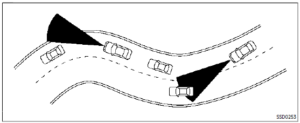
When driving on some roads, such as winding, hilly, curved, narrow roads, or roads which are under construction, the ICC sensor may detect vehicles in a different lane, or may temporarily not detect a vehicle traveling ahead. This may cause the ICC system to decelerate or accelerate the vehicle.
The detection of vehicles may also be affected by vehicle operation (steering manoeuvre or travelling position in the lane, etc.) or vehicle condition. If this occurs, the ICC system may warn you by blinking the system indicator and sounding the chime unexpectedly. You will have to manually control the proper distance away from the vehicle travelling ahead.
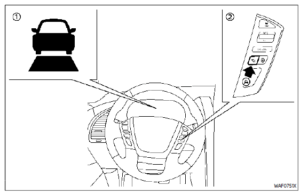
- ICC system warning (yellow)
- ICC switches
- MAIN (ON·OFF) switch
System temporarily unavailable
Condition A:
Under the following conditions, the ICC system is automatically cancelled. The chime will sound and the system will not be able to be set.
- When the VDC is turned off
- When the VDC operates
- When a tire slips
- When the SNOW mode switch is pushed on
- When the 4WD shift switch is in the 4H or 4L position (for 4WD models)
- When the radar signal is temporarily interrupted Action to take:
When the conditions listed above are no longer present, turn the system off using the MAIN switch. Turn the ICC system back on to use the system.
Condition B:
Under the following conditions, making it impossible to detect a vehicle ahead, the ICC system is automatically cancelled.
The chime will sound and the “Forward Driving Aids temporarily disabled Front Sensor blocked See Owner’s Manual” warning message will appear in the vehicle information display.
- When the radar sensor area of the front bumper is covered with dirt or is obstructed
Action to take:
If the warning message appears, stop the vehicle in a safe place, place the shift lever in the P (Park) position and turn the engine off. When the radar signal is temporarily interrupted, clean the sensor area of the front bumper and restart the engine. If the warning message continues to be displayed, have the ICC system checked. It is recommended you visit a NISSAN dealer for this service.
- When driving on roads with limited road structures or buildings (for example, long bridges, deserts, snow fields, driving next to long walls)
Action to take:
When the above conditions no longer exist, the ICC system will resume automatically.
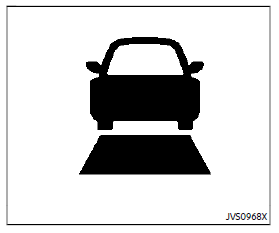
Condition C:
When the ICC system is not operating properly, the chime sounds and the ICC system warning (yellow) will come on.
Action to take:
If the warning light comes on, park the vehicle in a safe place. Turn the engine off, restart the engine, resume driving and set the ICC system again.
If it is not possible to set the system or the indicator stays on, it may indicate that the ICC system is malfunctioning. Although the vehicle is still drivable under normal conditions, have the vehicle checked. It is recommended you visit a NISSAN dealer for this service.

System maintenance
The sensor for the ICC system located below the front bumper.
To keep the ICC system operating properly, be sure to observe the following:
- Always keep the sensor area of the front bumper clean.
- Do not strike or damage the areas around the sensor.
- Do not cover or attach stickers or similar objects on the front bumper near the sensor area. This could cause failure or malfunction.
- Do not attach metallic objects near the sensor area (brush guard, etc.).
- This could cause failure or malfunction.
- Do not alter, remove or paint the front bumper. It is recommended you con-tact a NISSAN dealer before customizing or restoring the front bumper.
Radiofrequency statement
Model: ARS4–A
IC: 4135A-ARS4A
FCC ID: OAYARS4A
This device complies with Part 15 of the FCC Rules and with Industry Canada licence-exempt RSS standard(s). Operation is subject to the following two conditions:
- This device may not cause harmful interference, and
- This device must accept any interference received, including interference that may cause undesired operation.
CONVENTIONAL (fixed speed)
CRUISE CONTROL MODE
This mode allows driving at a speed between 25 to 90 MPH (40 to 144 km/h) without keeping your foot on the accelerator pedal.
WARNING
- In the conventional (fixed speed) cruise control mode, a warning chime does not sound to warn you if you are too close to the vehicle ahead, as neither the presence of the vehicle ahead nor the vehicle-to-vehicle distance is detected.
- Pay special attention to the distance between your vehicle and the vehicle ahead of you or a collision could occur.
- Always confirm the setting in the
ICC system display.
Do not use the conventional (fixed speed) cruise control mode when driving under the following conditions.- when it is not possible to keep the vehicle at a set speed
- in heavy traffic or in traffic that varies in speed
- on winding or hilly roads
- on slippery roads (rain, snow, ice, etc.)
- in very windy areas
Doing so could cause a loss of vehicle control and result in an accident.

Conventional (fixed speed) cruise control switch
- RES+ switch:
Resumes set speed or increases speed incrementally. - SET- switch:
Sets the desired cruise speed, reduces speed incrementally. - CANCEL switch:
Deactivates the system without erasing the set speed. - MAIN switch:
Master switch to activate the system.
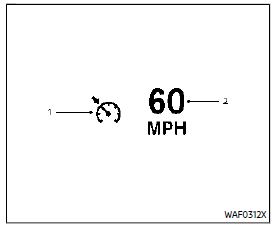
Conventional (fixed speed) cruise control mode display and indicators
The indicators are displayed in the vehicle information display.
- Cruise indicator:
This indicator indicates the condition of the ICC system depending on a color.- Cruise control ON indicator (gray):
Indicates that the ICC switch is ON. - Cruise control set indicator (green):
Indicates that the cruising speed is set. - Cruise control system warning (yellow):
Indicates that there is a malfunction in the ICC system.
- Cruise control ON indicator (gray):
- Set vehicle speed indicator:
This indicator indicates the set vehicle speed.

Operating conventional (fixed speed) cruise control mode
To turn on the conventional (fixed speed) cruise control mode, push and hold the MAIN switch for longer than about 1.5 seconds.
When pushing the MAIN switch on, the conventional (fixed speed) cruise control mode display and the MAIN switch indicator are displayed on the vehicle information display. After you hold the MAIN switch on for longer than about 1.5 seconds, the ICC system display goes out. The MAIN switch indicator stays lit. You can now set your desired cruising speed. Pushing the MAIN switch again will turn the system completely off.
When the ignition switch is pushed to the OFF position, the system is also automatically turned off.
To use the ICC system again, quickly push and release the MAIN switch (vehicle-to-vehicle distance control mode) or push and hold it (conventional cruise control mode) again to turn it on.
CAUTION
To avoid accidentally engaging cruise control, make sure to turn the MAIN switch off when not using the ICC system.
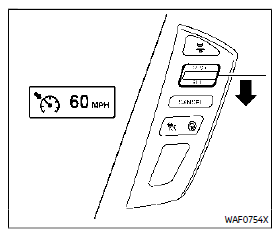
To set cruising speed, accelerate your vehicle to the desired speed, push the SET- switch and release it. (The color of the cruise indicator changes to green and set vehicle speed indicator comes on.) Take your foot off the accelerator pedal. Your vehicle will maintain the set speed.
- To pass another vehicle, depress the accelerator pedal. When you release the pedal, the vehicle will return to the previously set speed.
- The vehicle may not maintain the set speed when going up or down steep hills. If this happens, manually maintain vehicle speed.
To cancel the preset speed, use any of the following methods:
- Push the CANCEL switch. The set vehicle speed indicator will turn off.
- Tap the brake pedal. The set vehicle speed indicator will turn off.
- Turn the MAIN switch off. Both the MAIN switch indicator and set vehicle speed indicator will turn off.
To reset at a faster cruising speed, use one of the following three methods:
- Depress the accelerator pedal. When the vehicle attains the desired speed, push and release the SET- switch.
- Push and hold the RES+ set switch. When the vehicle attains the speed you desire, release the switch.
- 3. Push, then quickly release the RES+ switch. Each time you do this, the set speed will increase by about 1 MPH (1.6 km/h).
To reset at a slower cruising speed, use one of the following three methods:
- Lightly tap the brake pedal. When the vehicle attains the desired speed, push the SET- switch and release it.
- Push and hold the SET- switch. Release the switch when the vehicle slows down to the desired speed.
- Push, then quickly release the SET- switch. Each time you do this, the set speed will decrease by about 1 MPH (1.6 km/h).
To resume the preset speed, push and release the RES+ switch. The vehicle will resume the last set cruising speed when the vehicle speed is over 25 MPH (40 km/h).
System temporarily unavailable
Under the following conditions, a chime will sound and the system control is automatically canceled.
- When the vehicle slows down more than 8 MPH (13 km/h) below the set speed
- When the shift lever is shifted to the (Neutral) position
- When the parking brake is applied
- When the VDC (including the traction control system) operates.
- When a wheel slips
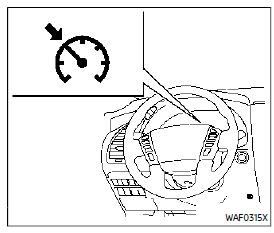
Warning light
When the system is not operating properly, the chime sounds and the system warning (yellow) will come on.
Action to take:
If the warning comes on, park the vehicle in a safe place. Turn the engine off, restart the engine, resume driving and then per-form the setting again.
If it is not possible to set or the indicator stays on, it may indicate that the system is malfunctioning. Although the vehicle is still drivable under normal conditions, have the vehicle checked. It is recommended you visit a NISSAN dealer for this service.
Q&A
What is Intelligent Back-up Intervention in the Nissan Armada 2022?
Intelligent Back-up Intervention is a safety feature in the Nissan Armada 2022 that helps the driver avoid collisions when backing up by automatically applying the brakes to prevent a collision with an object or pedestrian.
How does Intelligent Back-up Intervention work?
Intelligent Back-up Intervention uses radar and sonar sensors located on the rear of the vehicle to detect obstacles behind the vehicle. When an obstacle is detected, the system will sound an alert and apply the brakes if the driver does not respond.
Can the Intelligent Back-up Intervention system be turned off?
Yes, the Intelligent Back-up Intervention system can be turned off through the vehicle settings.
What is Intelligent Cruise Control in the Nissan Armada 2022?
Intelligent Cruise Control is a feature that allows the driver to set a desired speed and following distance, and the vehicle will automatically adjust the speed to maintain that distance from the vehicle ahead.
How does Intelligent Cruise Control work?
Intelligent Cruise Control uses radar sensors located on the front of the vehicle to detect the distance and speed of the vehicle ahead. The system will automatically adjust the speed of the vehicle to maintain a safe following distance.
Can the driver override Intelligent Cruise Control?
Yes, the driver can override Intelligent Cruise Control by pressing the accelerator or brakes, or by taking manual control of the vehicle.
What is the benefit of having an Intelligent Back-up Intervention in the Nissan Armada 2022?
The benefit of having an Intelligent Back-up Intervention is that it can help the driver avoid collisions when backing up and provide an extra layer of safety for pedestrians or objects behind the vehicle.
What is the benefit of having Intelligent Cruise Control in the Nissan Armada 2022?
The benefit of having Intelligent Cruise Control is that it can help reduce driver fatigue on long trips and provide a more comfortable driving experience by maintaining a safe following distance from the vehicle ahead.
How do I activate the Intelligent Back-up Intervention system?
The Intelligent Back-up Intervention system is automatically activated when the vehicle is put in reverse.
How do I adjust the following distance in Intelligent Cruise Control?
The following distance in Intelligent Cruise Control can be adjusted using the controls on the steering wheel.
How do I turn off the Intelligent Cruise Control system?
The Intelligent Cruise Control system can be turned off using the controls on the steering wheel or through the vehicle settings.
Can the Intelligent Back-up Intervention system detect all obstacles behind the vehicle?
No, the Intelligent Back-up Intervention system may not detect all obstacles behind the vehicle, and the driver should always check their surroundings before backing up.
Can the Intelligent Cruise Control system be used in all driving conditions?
No, the Intelligent Cruise Control system may not work in all driving conditions, such as heavy traffic or inclement weather.
How do I know if the Intelligent Back-up Intervention system is activated?
The Intelligent Back-up Intervention system will display an icon on the dashboard when it is activated.
How do I know if the Intelligent Cruise Control system is activated?
The Intelligent Cruise Control system will display an icon on the dashboard when it is activated and will also display the set speed and following distance.
Useful Link
View Full User Guide: Nissan ARMADA 2022 User Guide
Download Manuals: https://www.nissanusa.com/owners/ownership/manuals-guides.html
2023 Nissan Armada Specs, Price, Features and Mileage (Brochure)

